Motorola Moto G Review
by Brian Klug on December 18, 2013 2:00 PM EST- Posted in
- Smartphones
- Motorola
- Mobile
- *VA
- Cortex A7
- snapdragon 400
- Moto G
Display on mobile devices is one area where we’ve seen considerable improvement. Pixel density has gone up, contrast ratios have improved, and the emphasis on low power in a platform gated by its battery size means there’s always innovation happening. In the case of the Moto G, what we’re after should really be a display that looks visually appealing without any of the egregious issues that plague most midrange devices – poor viewing angles, low resolution, low contrast, dim displays.
On paper, the Moto G has what would probably have been a flagship display for a mobile device a year or two ago, it’s a 4.5-inch LCD with 1280x720 resolution and 326 PPI pixel density. The comparison point is the Moto X with a 4.7 inch AMOLED panel of the same 720p resolution and 312 PPI pixel density.
I’m pretty impressed with how the Moto G’s display looks. Subjectively, viewing angles are good, there aren’t any of the issues I normally attribute to non-flagship devices either with low pixel density or contrast that fails to please. There’s no light leakage at all from any of the corners.
One unfortunate thing about the Moto G I was sampled however is the presence of two small bubbles in the cover glass. I initially thought these were dust, but inspection with a microscope reveals they are in fact inhomogeneities in the cover glass.
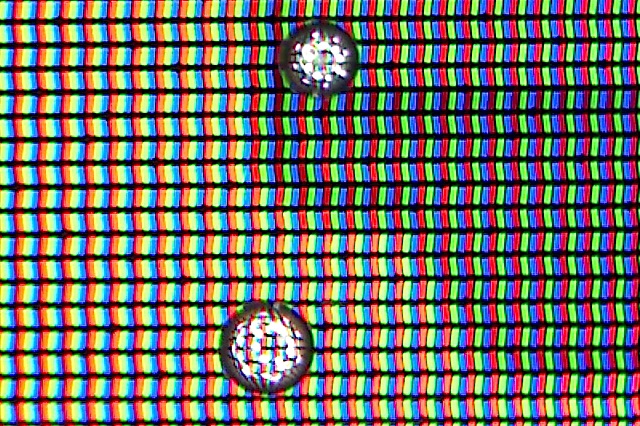
I’m not sure whether these kind of defects are within spec for the Moto G, but they’re distracting and visible on most solid colored UIs or views. I’ve never seen something like this on any handset I’ve reviewed to date.

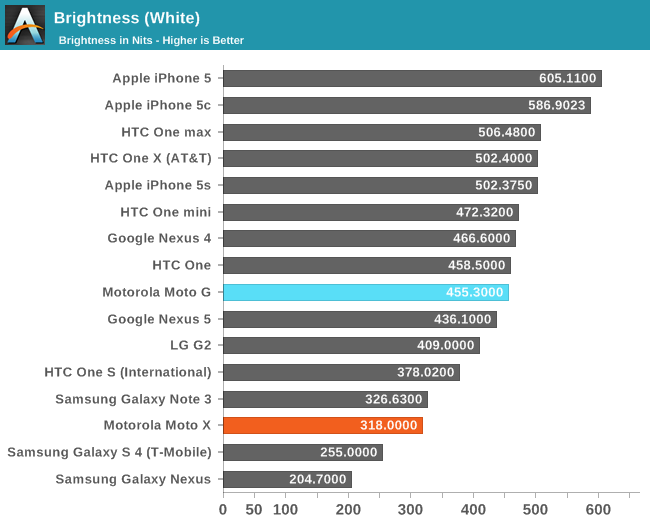

The Moto G goes plenty bright, at just over 455 nits, and delivers contrast numbers that are pretty darn good for the price point at just shy of 1200. Normally black levels are out of control on the lower end devices, I’m not sure if the Moto G uses an IPS panel, but suspect it does.
Upon inspection I immediately noticed that the Moto G display was very, very blue. To measure color accuracy we turn to the same combination of measures that we have used for a while now.
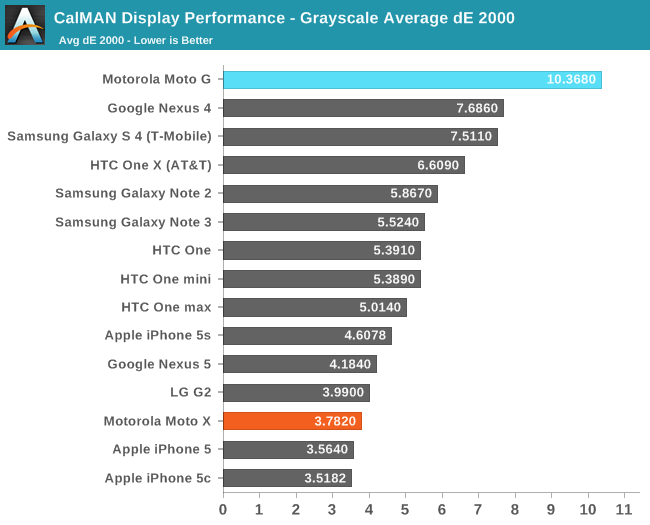
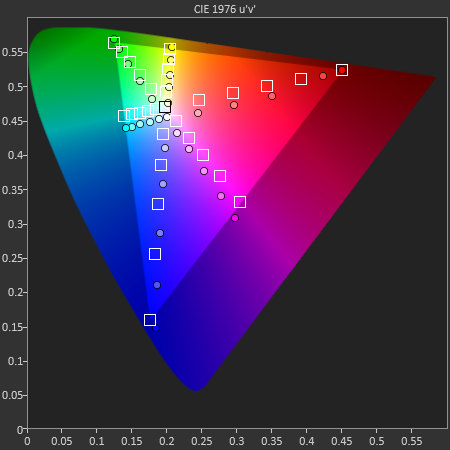



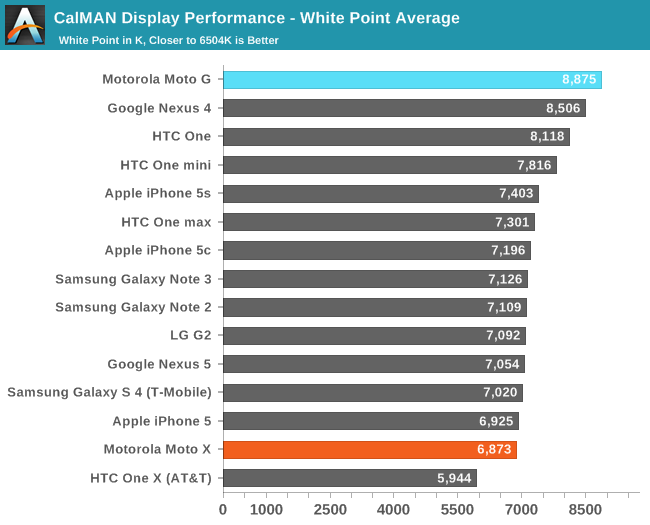
My comparison points are unfortunately primarily high end devices, which makes the Moto G look comparatively poor. The Moto G display tuning is indeed very blue with a white point of nearly 9000K, but I wouldn’t be surprised to learn this is a function of the backlight LEDs used or intrinsic properties of the panel.
Color calibration is something we’ve only just now started to see get taken seriously on the high end devices, if we can’t expect it to be a regular staple there, the midrange is obviously a lost cause. I wouldn’t fault the Moto G for not being very accurate, but it is something to be aware of as a sacrifice at this price point if you’re considering it over a high-end phone. On the flipside, the pixel density and contrast of the Moto G’s display seems excellent given the price, and I suspect the defects in my Moto G’s cover glass are specific to this unit.



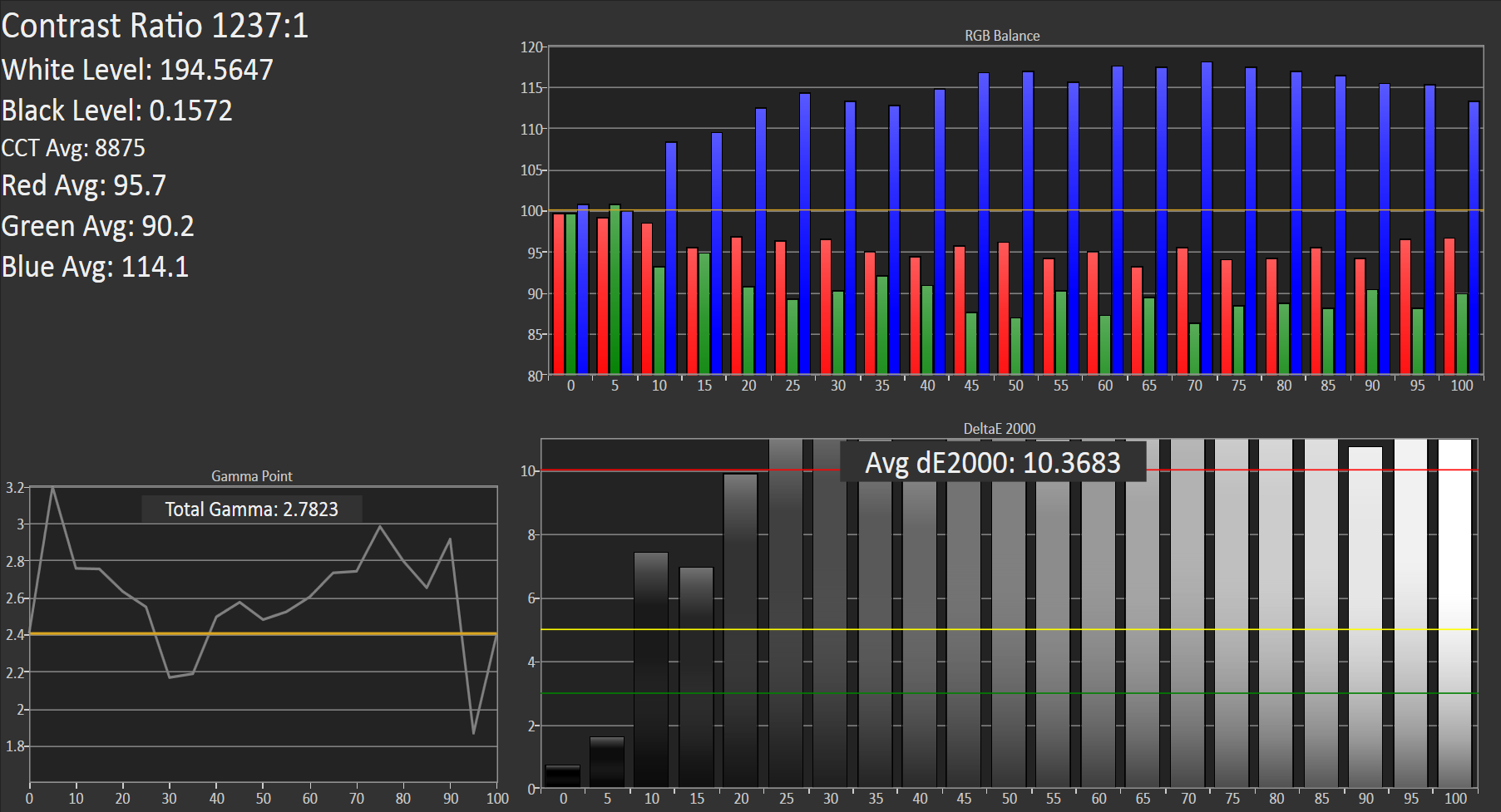








120 Comments
View All Comments
bhima - Monday, December 23, 2013 - link
The market are people that, for example, pay only $25 a month each on a T-mo family plan and they don't want to drop an extra $30 a month for 2 years for a phone, Or sign up for a contract with ATT/Verizon and blow easily $60+ a month. 500mb of data at HSPA+ speed (9mbps in my area) with no overage charge, unlimited talk and text for $25 a month makes this phone a huge winner to those willing to look for a good experience without burning a hole in your wallet.teiglin - Wednesday, December 18, 2013 - link
Every time I read reviews of this I'm surprised at how closely MSM8x26 performs to flagships from as recently as last year. Obviously it isn't really in the running compared to 8974, Apple A7, Exynos 5250, etc., much less APQ8064, so I think this says more embarassing things about companies that shipped quad-A9 flagships in mid-to-late-2012, but still, the end result is that the display and silicon leads to an experience comparable to (if not better than) a GS3 i9300. This is pretty surreal at the sub-$200 price point, while a new i9300 still goes for ~$400. Of course there are other sacrifices and if we're talking about $400 life begins and ends with the Nexus 5, but still, Motorola has really accomplished something with the Moto G. This is the phone I'd buy for my son if he were five years older; hopefully by the time he's old enough to have his own smartphone, Motorola will be still have something comparable on sale so he can get a quality device at this price point.teiglin - Wednesday, December 18, 2013 - link
Exynos 5420. Not really sure where 5250 came from, but... thingssayash - Thursday, December 19, 2013 - link
5250 is now more than a year old, it was the soc in the nexus 10, so yeah.Bobs_Your_Uncle - Thursday, December 19, 2013 - link
By the way, how's that Nokia 1020 review coming?Klug4Pres - Thursday, December 19, 2013 - link
Brian, I am curious about the impact of operating system version on the benchmark comparisons. Presumably the results in your tables are based on whatever version was installed at the time of initial testing, which is perfectly reasonable.However, it would be interesting to gauge the impact of, for example, new Android versions on a device's scores. Is there an appreciable change in performance going from, say, 4.2 to 4.3 or 4.4 on Nexus 4?
I realise it would be a lot of work to try to update all benchmarks on every software release across every OEM, and anyway you do not necessarily retain access to most of the devices you test, but this might be feasible on just the Nexus devices, which I have a feeling you tend to keep around. On the other hand, maybe the results aren't really very interesting.
Qwertilot - Thursday, December 19, 2013 - link
Fascinating to see what happens with and its relatives/competition in next few years.In a sane world this sort of thing would take huge chunks of the market for high end phones. The current market with the very expensive ultra high end models selling so much at such premiums surely can't be sustainable long term.
Only thing is that I'm not sure how rational this market is :)
uhuznaa - Thursday, December 19, 2013 - link
With smartphones and tablets becoming a mass-market it will be as rational as any other market. Like clothing, shoes or food. Which means not very rational, there will be room for huge price spans and very different products, some of them rational and others not at all. This is hard to digest for geeks, I know.Qwertilot - Thursday, December 19, 2013 - link
True. The special thing for the mobile market is the rather big locked in distortions via contracts/subsidies etc.Certainly nice to have this sort of option around.
ESC2000 - Monday, December 23, 2013 - link
problem is that the average person thinks s/he needs the newest shiniest most powerful device that she will probably never take advantage of, and the up front subsidy (but pay out the rear) system facilitates the impulse to purchase an overly powerful device in the US by making Americans less price sensitive. It is really annoying to listen to people who think a small very powerful computer that pushes more pixels than their laptop only costs - and should only cost - $200 at most.